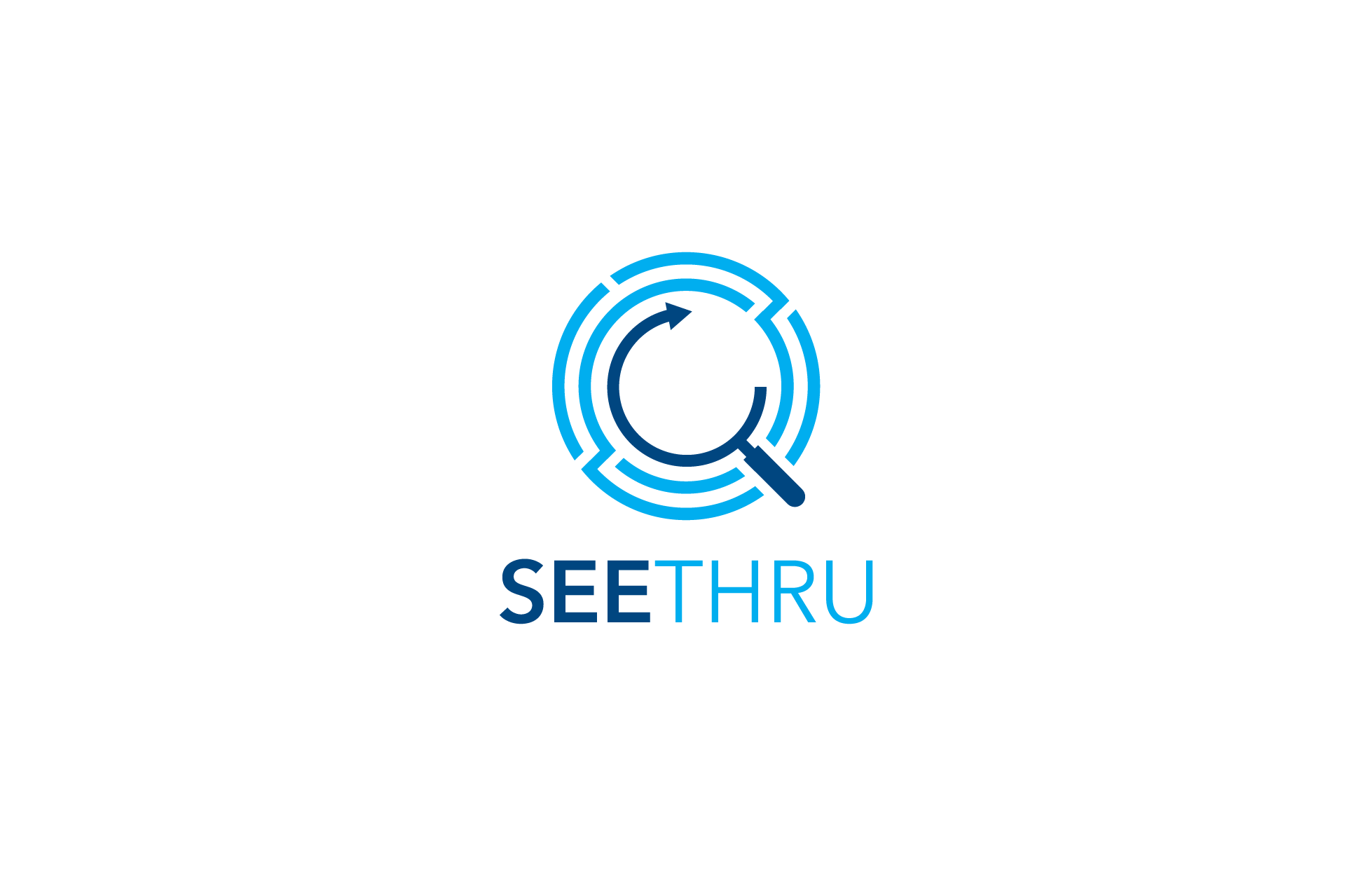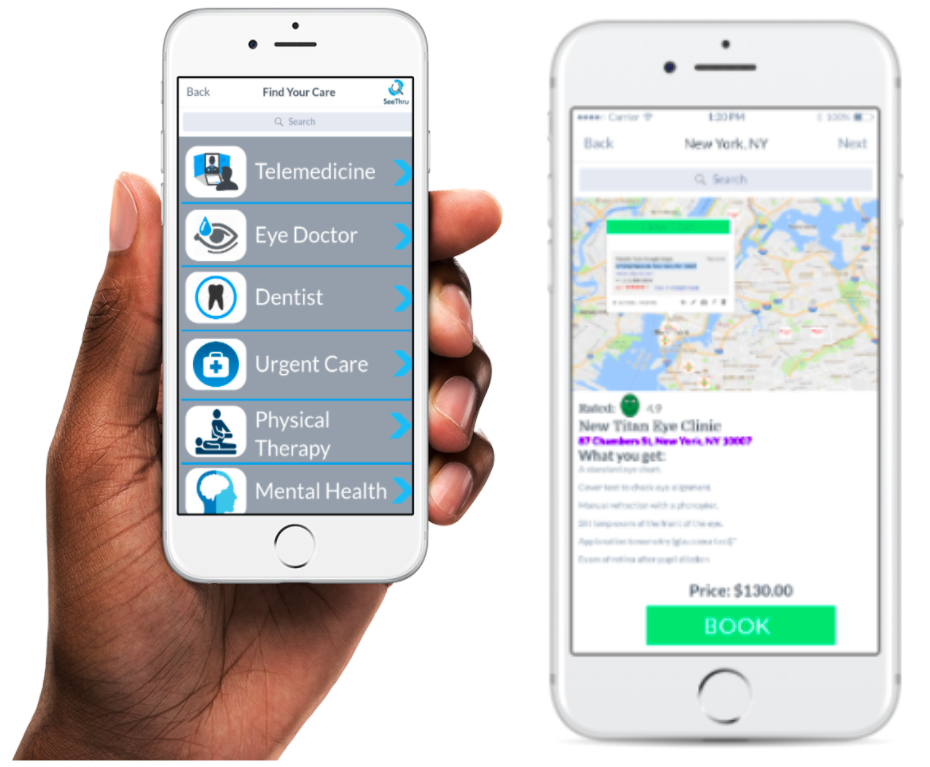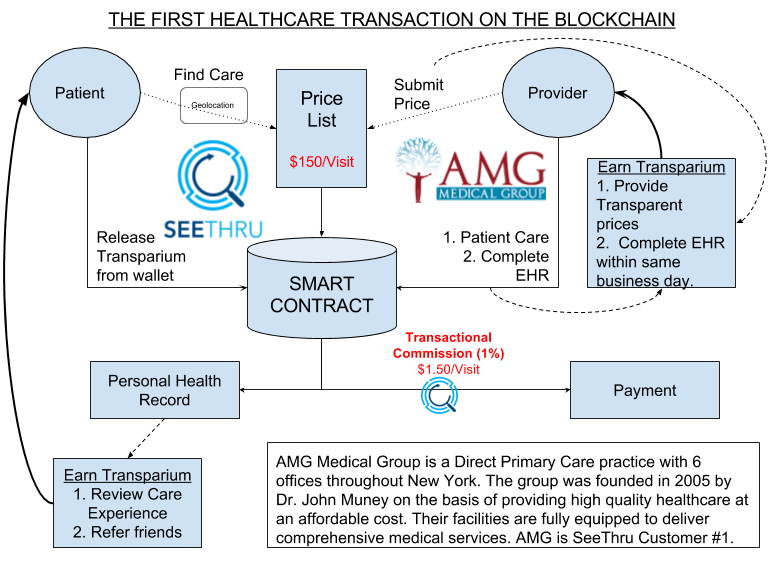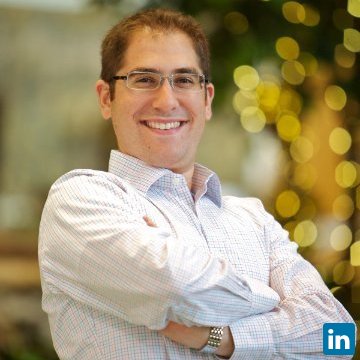SeeThru: Blockchain Ecosystem for Healthcare Transparency
by Adi Y. Segal

SeeThru is a blockchain platform that is changing the world of healthcare payments, price transparency, and personal medical records.
New York, NY United States Blockchain For the Doctors Office Hospital Solutions Equity Raise MedMo18 challengeAbout our project
The problem we solve: Americans pay too much for healthcare and don’t get enough from the system. On average, we are spending $10,000 per person annually. In the last 10 years out-of-pocket spending alone has risen over 230%. Today in the U.S., patient out-of-pocket spending - this is additional money to costs covered by insurance - totals nearly $500 billion and is expected to reach $608 billion by 2019 according to CMS. Medical expenses is the number one reason why Americans file for personal bankruptcy. On the other side of the coin, providers are only collecting 35-40% of billed services and according to McKinsey & Company revenue cycle inefficiencies accounted for 15% of the $3.5 trillion national healthcare spend last year. Simply put, patients are emptying their bank accounts to pay for healthcare they are not receiving and doctors are not getting fully compensated for the care they are providing.

About our solution: The SeeThru platform offers a technology enabled free market approach to solving this issue in totality. SeeThru is a blockchain ecosystem that is changing the world of healthcare payments, price transparency, and personal medical records. The solution increases patient health savings and grows provider revenue, while driving down the cost of care, through our cryptocurrency, Transparium. SeeThru brings patients the sorely needed value-based consumer experience found in every other industry. This ecosystem has global implications and aims to democratize healthcare around the world.

Progress to date:
We have completed our MVP and are working with our beta customer, AMG Medical Group to perform the first healthcare transaction on the Lighting Network blockchain. Informal surveys have shown that there is great excitment for this type of helthcare ecosystem on the provider and patient sides. Both parties feel paralyzed in the current system and are eager to see how to bring prices down and still get paid suffiencelty, creating a much more sustainable healthcare model.
Belwo is an example of how the SeeThru platform works:
Jane lives on the Upper East Side of Manhattan and has a high deductible health insurance plan. She needs to spend $4,500 out-of-pocket before any healthcare services are covered. Therefore, it behooves Jane to shop around before making a doctor’s appointment. She wants to find the highest value care (i.e., best quality at lowest price). So when Jane comes down with laryngitis, she logs on to the SeeThru app, sharing her location and symptoms. Immediately, she can view all the providers in the area who will see her for their direct pay price (generally much less than the “negotiated” insurance rate). Just like on Amazon, Jane sorts and filters the results by price and quality to match her spending comfort. She quickly finds Dr. John Muney at the AMG Medical Group with six offices throughout New York City. She can be seen the same day for $125 (excluding additional lab work and diagnostics, which would be discussed at the point of service with transparent prices before any services were added). Dr. Muney has guaranteed at least 15 minutes with her and she’s welcome to stay in the office as long as she needs to have all of her questions answered. In order to schedule the visit, Jane must pay ahead thru the SeeThru platform. Her fiat ($USD) is immediately exchanged into Transparium (our cryptocurrency) and placed in a smart contract to be released after the visit. Since Jane has used SeeThru before, her medical record is already in the system and will be shared with Dr. Muney regardless of where she’s been seen in the past. Jane arrives five minutes early, seamlessly checks in and and is seen on time. She oddly enjoys her time at the doctor’s office! At the end of the visit, Jane provides a authentication key for Dr. Muney to confirm that the session is complete. Afterwards, Dr. Muney updates Jane’s electronic health record. Upon submission of this data, the smart contract is released, Transparium is exchanged for $USD and AMG Medical Group is immediately paid. In this encounter, Jane saved lots of time and money searching for affordable, high quality care. Dr. Muney gained a new patient and kept over 8% of his revenue that would have been wasted on billing services and transaction fees.
About Our Team

Creator: Adi Y. Segal
Location: New York
Education: Columbia University
Bio: Adi founded SeeThru after leaving medical school to change healthcare. Adi previously worked at Genoa Telepsychiatry, a healthtech startup and the nation’s largest provider of outpatient telepsychiatry. Prior to launching SeeThru, Adi served as COO of DN Telehealth and completed a term as Entrepreneur in Residence at Mount Sinai’s Icahn School of Medicine, where he helped spin off a mobile healthcare platform. A graduate of Columbia University, Adi began his career working on healthcare economics and access to care issues at The Leukemia & Lymphoma Society. He brings a unique blend of experience from urban studies, experiential education, outdoor adventure leadership and team building, environmental advocacy, and Emergency Medical Services.
Title: CoFounder / CEO
About Our Company
SeeThru
Location: 475 Park Ave S
11th Fl
New York, NY 10016
US
Founded: 2016
Product Stage: Prototype/MVP
YTD Sales: Working on it
Employees: 3-5
How We Help Hospitals
Cuts down on costs, increases patient trust and satisfaction.
Challenge Mission
Market Opportunity
$9.8 Billion: Our initial target is to disrupt the healthcare revenue cycle management industry in the United States (Becker's Healthcare). Then, given that we are building a new worldwide healthcare economy, ideally our TAM could reflect a portion of the global health spend, which is expected to reach $8.7 trillion by 2020 (McKinsey). That said, a more realistic market size at this time is the total out-of-pocket spending for healthcare in U.S. at $500 billion, according to CMS.
Key Milestones Achieved and Planned
Within 3 years we hope to offer healthcare services on platform in every state throughout the USA and at least 15 countries around the world. We plan to grow rapidly and broadly as a blockchain solution, especially after our token generation event. Our goal is to capture 1% of global healthcare spend (at $10 trillion) with a 1% margin from transactional commission, resulting in $1 billion in revenue by Q3 2021.Our Competitive Advantages
- 1%-2% of transactional commission. The goal is to stay below the cost of traditional payment processors. As we scale and gain efficiencies proving additional ROI for providers we will be able to increase our margins.
- Per life price to manage a company’s health plan.
- [Part of a 5 year plan] premium concierge services and discounts for annual D2C consumers.
Barriers to Entry
There is no other company building our exact solution. Nonetheless,
- ZocDoc as scheduling and review service is considered a traditional competitor. However, they don’t currently do payment processing and this vertical does not fit with their business model.
- Amino is an excellent resource for aggregated data that provides very accurate estimates of healthcare cost based on zip code, treatment, and payment plan. But, they do not offer guaranteed point-of-service pricing and purchasing.
- Castlight and Curisium both offer transparent contracting via employer, with no direct to consumer platform.
PokitDok recently published a blockchain white paper discussing how they can utilize their large healthcare dataset, though the exact plans are unclear and we still view them as a channel partner. - Many of the other companies selling direct pay healthcare services will actually be collaborators in our marketplace rather than competitors. At present, our biggest competition is simply word of mouth referrals for patients finding a provider.
Traction, Funding and Partners
We currently have our first beta customer-partner. AMG Medical Group is a Direct Primary Care practice with 6 offices throughout New York. The group was founded in 2005 by Dr. John Muney on the basis of providing high-quality healthcare at an affordable cost. Their facilities are fully equipped to deliver comprehensive medical services. One we prove out our model here we will rapidly expand to private practices throughout NYC. Within one year we hope to have at least one strategic partnership with a large healthcare system.
Innovation Details
Intellectual Property Summary
The IP in our project lies in our approach to the market and execution. We would not be granted patents for our digital platform (see: Alice v. U.S.). Ultimately, we may be able to patent our blockchain algorithm, but we are not currently at that stage.
Clinical Information
No clinical trials or FDA clearance needed. But here are some links:
http://www.healthcostinstitute.org/report/2016-health-care-cost-utilization-report/
https://www.kff.org/health-costs/report/2017-employer-health-benefits-survey/
http://healthcare.mckinsey.com/sites/default/files/793544_Hospital_Revenue_Cycle_Operations.pdf
https://www.nytimes.com/interactive/2014/12/18/health/cost-of-health-care-poll.html
D. I. Auerbach and A. L. Kellermann, “A Decade of Health Care Cost Growth Has Wiped Out Real Income Gains for an Average U.S. Family,” Health Affairs, Sept. 2011 30(9):1630–36
Gerard F. Anderson, Uwe E. Reinhardt, Peter S. Hussey and Varduhi Petrosyan It's The Prices, Stupid: Why The United States Is So Different From Other Countries Health Affairs 22, no.3 (2003):89-105 doi: 10.1377/hlthaff.22.3.89
Regulatory Status
N/A
How we will use the funds raised
50%: Tech Developement
30%: Operations + Legal
20%: Marketing (provider and patient recruitment)
Thank You
Healthcare in America is opaque and unaffordable. It is the only “consumer experience” wherein we do not know the cost or quality of the offering/product before we commit to paying. Over the last decade healthcare coverage has changed and now more Americans have fewer benefits with high deductible plans and find themselves shopping around for care without the necessary tools. Medical debt is the top reason in the U.S. individuals file for personal bankruptcy. According to CMS data, last year Americans spent $500 billion on out-of-pocket costs. The PRICE of healthcare is crippling our society. For providers, the cost of business is also detrimental. On average, practices spend 15% of their annual revenue collecting the rest of their income and the revenue cycle management industry will reach a $9B market cap this year. SeeThru provides a transparent marketplace for healthcare services (and eventually goods), which uses free market economics to drive down prices and allow patient-consumers to intelligently shop around for healthcare across the country and around the world. Our blockchain solution allows for direct smart contracts between patients and providers, eliminating third parties.
Whether you have the best insurance in the world or none at all, price transparency is something that affects everyone's healthcare experience. We have the opportunity to shift the paradigm of how healthcare is sold and consumed. Please join this global movement to reclaim our health! THANK YOU.
Investor Info
Market Size
$9.8 Billion: Our initial target is to disrupt the healthcare revenue cycle management industry in the United States (Becker's Healthcare). Then, given that we are building a new worldwide healthcare economy, ideally our TAM could reflect a portion of the global health spend, which is expected to reach $8.7 trillion by 2020 (McKinsey). That said, a more realistic market size at this time is the total out-of-pocket spending for healthcare in U.S. at $500 billion, according to CMS.
Projected 3 Year Growth
Within 3 years we hope to offer healthcare services on platform in every state throughout the USA and at least 15 countries around the world. We plan to grow rapidly and broadly as a blockchain solution, especially after our token generation event. Our goal is to capture 1% of global healthcare spend (at $10 trillion) with a 1% margin from transactional commission, resulting in $1 billion in revenue by Q3 2021.
Revenue Model
- 1%-2% of transactional commission. The goal is to stay below the cost of traditional payment processors. As we scale and gain efficiencies proving additional ROI for providers we will be able to increase our margins.
- Per life price to manage a company’s health plan.
- [Part of a 5 year plan] premium concierge services and discounts for annual D2C consumers.
Competitors
There is no other company building our exact solution. Nonetheless,
- ZocDoc as scheduling and review service is considered a traditional competitor. However, they don’t currently do payment processing and this vertical does not fit with their business model.
- Amino is an excellent resource for aggregated data that provides very accurate estimates of healthcare cost based on zip code, treatment, and payment plan. But, they do not offer guaranteed point-of-service pricing and purchasing.
- Castlight and Curisium both offer transparent contracting via employer, with no direct to consumer platform.
PokitDok recently published a blockchain white paper discussing how they can utilize their large healthcare dataset, though the exact plans are unclear and we still view them as a channel partner. - Many of the other companies selling direct pay healthcare services will actually be collaborators in our marketplace rather than competitors. At present, our biggest competition is simply word of mouth referrals for patients finding a provider.
Traction
We currently have our first beta customer-partner. AMG Medical Group is a Direct Primary Care practice with 6 offices throughout New York. The group was founded in 2005 by Dr. John Muney on the basis of providing high quality healthcare at an affordable cost. Their facilities are fully equipped to deliver comprehensive medical services. One we prove out our model here we will rapidly expnd to private practices throuhgout NYC. Within one year we hope to have at least one strategic partnerhsip with a large healthcare system.
Due Diligence Docs
Please note that access to the company's confidential materials is limited. Click this button to request access from the Company and its representatives.
Updates
No updates found .
Supporters
There are not supporters yet.
Help us find best new ideas to fund by telling us what you think. Your feedback goes straight to the team behind this project in private, so tell them what you really think.
Index Score
36
Score
0
Score
1
Likes0
Partners0
Pilots0
Follows-
This campaign has ended but you can still get involved.See options below.
Help us find best new ideas to fund by telling us what you think. Your feedback goes straight to the team behind this project in private, so tell them what you really think.

